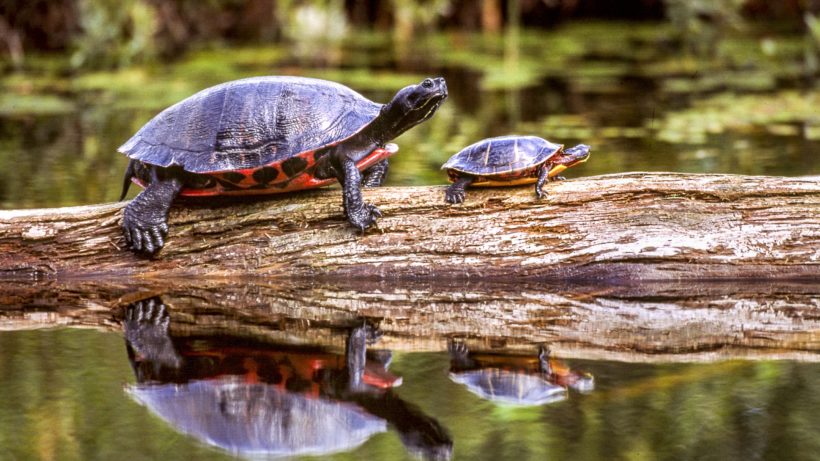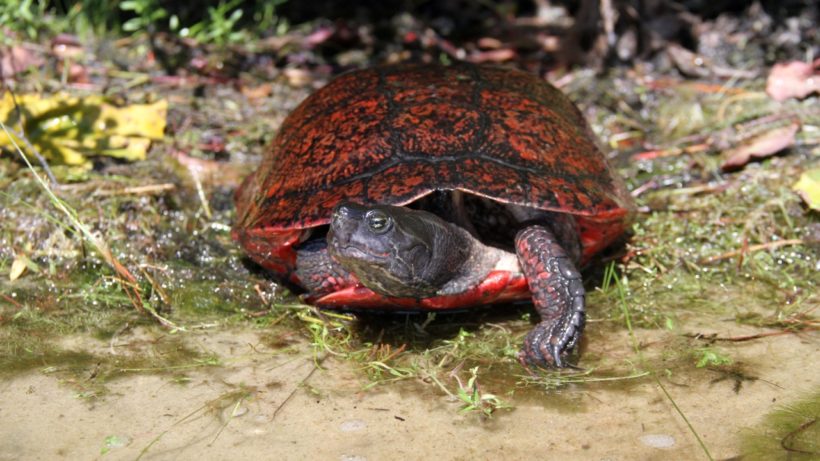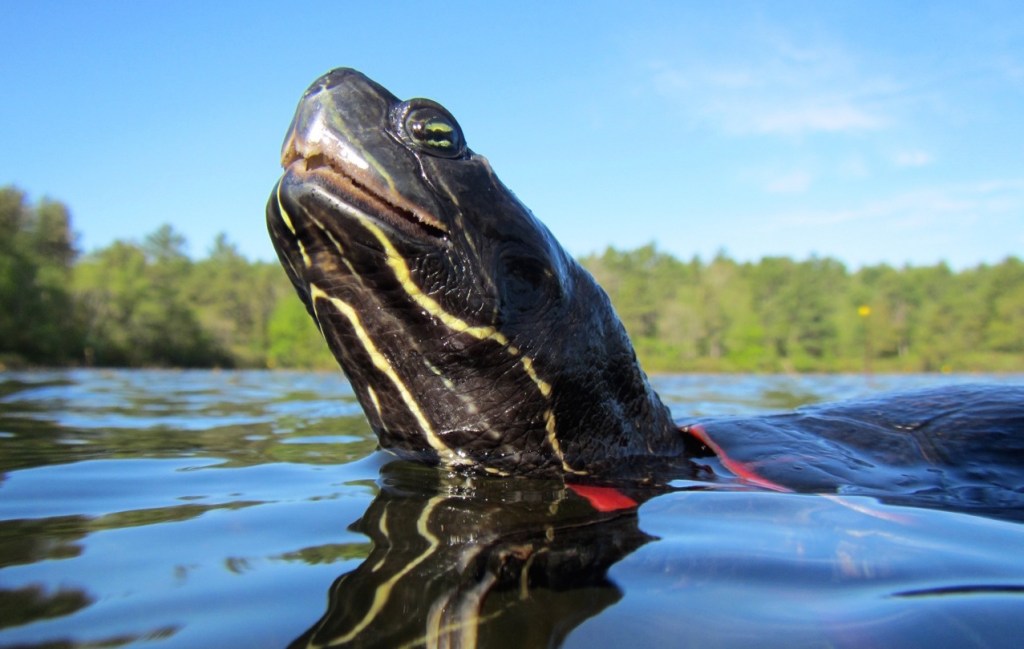“Conservation” is no longer enough. Instead of just saving what’s left we need to restore what’s lost.
Neither I nor half a dozen of my colleagues at the Massachusetts Division of Fisheries and Game could identify the strikingly beautiful turtle at our feet. It was about ten times the size of a mature painted turtle — with a black, domed carapace, a crimson plastron, and a black neck. “It can’t be from Massachusetts,” someone ventured, wrongly. The year was 1971.
Presently, mobile encyclopedia Jim Cardoza appeared, informing us that it was a female Plymouth red-bellied turtle. In addition to being beautiful she was dead, having drowned in one of our fyke nets we’d set to sample fish in the Billington Sea (which drains into Plymouth Harbor and was named for its discoverer, Mayflower passenger Francis Billington who mistook this freshwater pond for part of the ocean).
Federally endangered Plymouth redbellies (or “northern red-bellied cooters,” as herpetologists prefer) exist only in Plymouth County, Massachusetts. They’re a “disjunct population” of the red-bellied cooter, whose northern range ends 250 miles south of Massachusetts.
While northern and southern populations are considered one species, there are subtle but probably important genetic differences. Anyone suggesting that we shouldn’t worry about Plymouth redbellies because the “same turtle” is secure along the coastal plain from New Jersey to North Carolina and inland to West Virginia ought not to be entrusted with wine selection. Virtually all wines are made from one species of grape.
In 1971 the Massachusetts Division of Fisheries and Game existed to serve sportsmen who provided our salaries by buying hunting and fishing licensees. The agency’s basic management philosophy was: If you can’t legally kill it, it’s not wildlife.
At that time there were, at best, 300 Plymouth redbellies on the planet, most geriatric. Reproduction had all but ceased. Extinction appeared imminent.
Cut to July 26, 2015. I am standing on a dirt-covered bridge over the narrows of East Head Pond at the Myles Standish State Forest in Carver, Massachusetts. Surrounding me is the largest pitch pine/scrub oak forest in New England. This redbelly habitat is protected by the state forest, sprawling Boy Scout reserves to the east and west, and to the south by land recently purchased by my old agency, now appropriately renamed the Division of Fisheries and Wildlife.
The morning sun is hot and bright, the air fragrant with the first blooms of sweet pepperbush. In front of newly opened water lilies a dozen largemouth bass hold in the light flow. Where the pond widens and wanders east, a carpet of green fanwort underlies the waveless surface.
As the sun climbs, redbellies haul out to join glistening baskers on deadfalls. Several are the size of the dead one I’d seen 44 years earlier. They share one log with painted turtles. In the water both species ease their heads into the air, carapaces barely showing.

A Headstart Program…For Turtles
Public priorities changed during the 1970s. In 1983 the U.S. Fish and Wildlife Service established the Massasoit National Wildlife Refuge, primarily to recover redbellies.
In 1985 there were no redbellies in East Head Pond. But that was the year the division’s robust Natural Heritage and Endangered Species Program (non-existent when I worked for the agency) began its “headstart” program by which captive hatchling redbellies are raised all winter. Come spring, they’re about the size of mature painted turtles and therefore pretty safe from predators. It’s the largest freshwater turtle headstart program in the world.
Last year division biologists counted 40 redbelly nests around East Head, every one constructed by a headstarted female. “Except for a small bog-turtle project in Tennessee, we’re the only one to confirm headstarts reproducing in the wild,” says Dr. Thomas French, director of the Natural Heritage and Endangered Species Program. “Now we’re on the verge of seeing reproduction by headstart offspring.”
At the most prolific redbelly pond a consultant checks for turtle tracks twice a day during nesting season, then places a predator-proof cage over nests he finds. For headstarting he takes only two or three hatchlings from each clutch of 10 or 12, thereby ensuring genetic diversity.
No hatchlings are taken from East Head, and nests aren’t caged. Predators consume the vast majority of eggs and hatchlings. But now, with natural reproduction augmented by only a few headstart releases, enough turtles make it to adulthood so that East Head’s population is stable and maybe increasing.
The division farms out hatchlings to 23 volunteer groups — mostly schools. So far, it has released 3,878 headstarts in suitable habitat. The wild population has increased by a factor of about 10 and is thought to be reproducing in at least 13 ponds and two river systems.
Toward noon Brian Bastarache, a teacher at Bristol County Agricultural High School in Dighton, Massachusetts, joins me on the bridge. Bastarache and his students raised 36 hatchlings this past winter, the most by far of all groups.
Redbellies are vegetarians, so headstarts are fed greens like leaf lettuce. They beg by racing toward the edge of the aquarium and paddling frantically. Heat lamps for basking and submersible heaters are essential. One volunteer group doubted any turtle could make it only on greens, so it gave its hatchlings krill, killing the lot.
Bastarache isn’t just raising turtles; he’s raising turtle advocates. “We do applied math and science by weighing and measuring our turtles every week, then crunching the numbers,” he says. “That’s more fun than book math and science.”
At the Boy Scout’s Camp Cachalot, embracing more redbelly habitat, I meet one of Bastarache’s students — Dan Kyne. “Headstarting is something I’ll remember all my life,” he tells me. “I’ll always be able to say that when I was a high-school kid I helped save turtles.”

Alien Turtles Infest Redbelly Waters
Headstarting has bought the Plymouth redbelly lots of time, but it’s not a cure-all. Threats remain. Suppression of fire, with which pitch pine, scrub oak and redbellies evolved, is reducing open areas for nesting. Turtle predators like skunks and raccoons are proliferating on human garbage. The bass and fanwort I’d seen are aliens. Bass take hatchlings; and, by depleting dissolved oxygen, decaying fanwort is a suspect in recent winterkill of hibernating adults.
And now alien turtles — red-eared sliders — infest redbelly water. Turtle farms in the South pump out red-eared sliders by the millions, selling them to the Chinese and Buddhists for food and the ancient tradition of fangsheng (“release of life”) in which the devout supposedly generate positive karma by the “kindness” of freeing animals.
But releasing aggressive and frequently diseased red-eared sliders devastates native turtles, not just in Massachusetts but around the nation and globe. “I couldn’t understand why red-eared sliders were suddenly exploding,” says Dr. French. “Now I think these Buddhist ceremonies explain it. While we’re releasing 100 [redbelly] juveniles they’re releasing 100 [slider] adults.”
Fortunately, there’s an influential and ecologically literate monk at the Grace Gratitude Buddhist Temple in Manhattan. The Venerable Benkong Shi upbraids his flock, renaming their illegal ritual fangsi (“release of death”) and reporting those who engage in it to environmental police.
Recently Benkong accepted French’s invitation to visit division headquarters in Westboro, Massachusetts. “No,” he replied when French suggested that fangsheng practitioners release headstarted redbellies instead of sliders. “They will release them one day, eat them the next.”
So French and Benkong have come up with a safe substitute for red-eared sliders. They’ll invite Buddhists to the division’s trout hatcheries and have them perform fangsheng on the fish before they’re stocked.
From Camp Cachalot I return to East Head Pond. Now the big log that had been in pitch-pine shadows is lit by the afternoon sun. It’s collecting more and bigger baskers.
As I stand on the bridge watching the turtle show I think of all the bad news about fish and wildlife that gets reported, about all the good news that doesn’t, and about how I’ve been as guilty as any writer in perpetuating the imbalance.





Ok, here goes… I have rescued turtles off of highways and roads for years. I find better safer environments for them. Large wooded forest for box turtles. Large lakes for snapping turtles and sliders. I found a small Terrapin turtle while biking on Ocracoke island. It was on the road, so I put it in a small estuary /cove thick with snails about 50 feet away from the road. All fun events. However today I have rescued a very red/black bellied cooter turtle. It was on highway 40 interstate. An almost impossible rescue, but I got lucky with the time of day and traffic. I have never seen this turtle before. It’s a deep red, shell and body. It’s about a 6 inch shell; definitely male. I am reading a lot about this beautiful reptile. It appears to be in the threatened endangered status. I live in Winston Salem N.C. I would like to place it in a safe and beneficial (for it species) location. I would welcome any suggestions. At this writing I am thinking lake mattamuskeet nature preserve would be ok. Does anyone have a take on this? Thank you
I have pictures of a turtle that was in our yard. Wondering if its a Plymouth Red Belly turtle. How can I forward photos to you?
Thank you for all that you have done & continue to do to save OUR EARTH.
Hi Ted,
Great article and thanks for sharing insight on this rare turtle….I’ve seen a few red bellied turtles in Plymouth ponds mostly clear,” kettle like” clear water sandy ponds.
Praise for pointing out the imbalance in the media coverage between positive and negative stories.
My own 44-year-old story regards the bald eagle. Turning thirteen in 1973, not long after the rivers were burning and Rachel Carson was a lone voice in the wilderness, I was certain that our national symbol (United States) was something I’d never see outside of a zoo. It looked like it was all over, just as it was for the ivory-billed woodpecker and the California condor. As a child-turning-adult, this no doubt helped shape my understanding and perception of wildlife decimation.
For a couple of decades I was convinced that these precious species and others would continue to meet their demise, most often as the result of human impacts. It was a sad, Orwellian view of the future.
Cut to the present. Alas, the carrier pigeon and the ivory-billed woodpecker will not return (unless there’s a real Jurassic Park in the future), however, I’ve had the privilege of spotting a number of bald eagles in the wild, including one right around my home. My nephew lives next door to Miles Standish State Forest, and it’s heartwarming to know my grandniece will be able to see these beautiful turtles as she grows up in a world with a different attitude towards destruction of species and habitats. Next time I visit him, I’ll go looking for the redbelly!
The California condor, the gray wolf, the American bison and countless other, less high-profile species have been restored or are showing signs of progress. We’ll never be out of the woods. Humankind has done, and continues to do, so much irreparable damage to our own environment.
It’s encouraging to see efforts like this, supported not only by citizen scientists, volunteers and environmental groups, but also embraced and promoted by our government agencies.
On behalf of the millions of creatures who benefit, THANK YOU!
Scott R. O’Connor
Schoharie Valley, New York